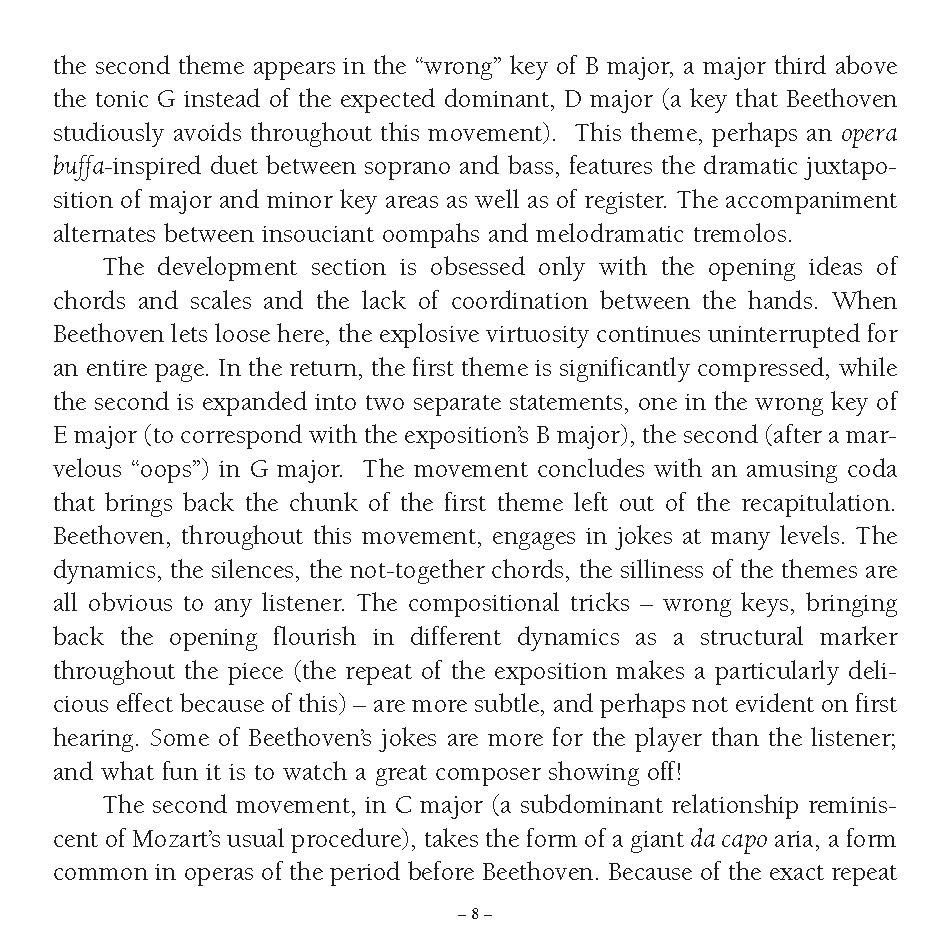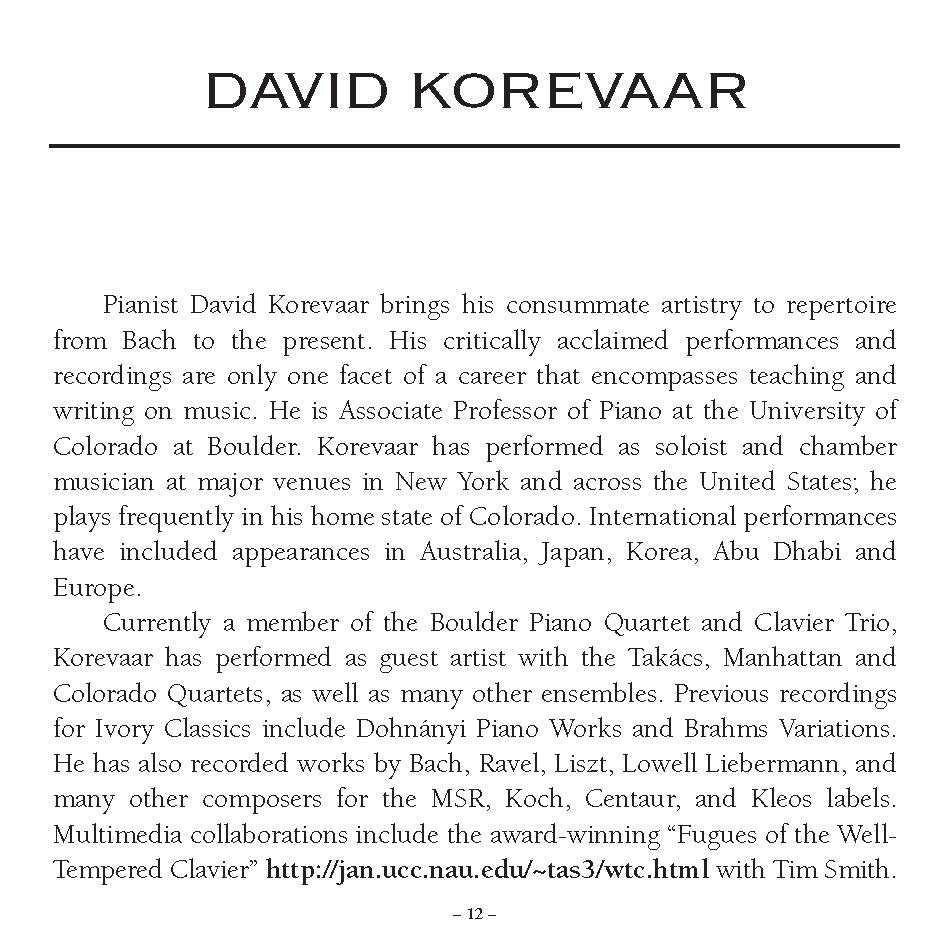NaN
/
of
-Infinity
David Korevaar: Beethoven Piano Sonatas Opp. 101, 31/1 & 111
David Korevaar: Beethoven Piano Sonatas Opp. 101, 31/1 & 111
Regular price
$15.00 CAD
Regular price
Sale price
$15.00 CAD
Unit price
/
per
Couldn't load pickup availability
Ivory Classics CD-77004
David Korevaar: Beethoven Sonatas (No. 28, 16 & 32)
Ludwig van Beethoven (1770-1827):
Piano Sonata No. 28 in A Major, Op. 101
01. Etwas lebhaft und mit der innigsten Empfindung03:57 ('06)
02. Lebhaft. Marschmäßig05:55 ('06)
03. Langsam und sehnsuchtvoll - Zeitmaß des ersten Stückes -03:00 ('06)
04. Geschwinde, doch nicht zu sehr, und mit Entschlossenheit08:21 ('06)
Piano Sonata No. 16 in G Major, Op. 31, No. 1
05. 1st Mvt.: Allegro vivace06:47 ('06)
06. 2nd Mvt.: Adagio grazioso12:59 ('06)
07. 3rd Mvt.: Rondo: Allegretto06:34 ('06)
Piano Sonata No. 32 in C Minor, Op. 111
08. 1st Mvt.: Maestoso: Allegro con brio ed appassionato08:57 ('06)
09. 2nd Mvt.: Arietta: Adagio molto semplice e cantabile19:57 ('06)
Piano: David Korevaar
Producer: Michael Rolland Davis
Engineer: Ed Thompson
Recorded at Holy Trinity Lutheran Church, Buffalo, New York - May 2006
Original 24-Bit Master Recorded direct to the Sadie Artemis
24-Bit High Resolution disk editor.
Shigeru Kawai Master Piano Artisan: Takanori Otake
Piano: Shigeru Kawai EX Concert Grand #2425001
Special thanks to: Pastor Charles Bang of the Holy Trinity Lutheran Church, Buffalo, N.Y. and Brian Chung, Senior Vice President of Kawai of America
David Korevaar photo on back of booklet by: Bob Bedrossian ©2007
Liner Notes: David Korevaar
Design: Samskara, Inc.
David Korevaar performs three major Beethoven Piano Sonatas - Op. 101; Op. 31, No. 1 and Op. 111. Recorded in the wonderfully accustical Holy Trinity Lutheran Church in Buffalo, NY. in May of 2006 on a Shigeru Kawai Concert Grand, this recording is outstanding in every way. (DDD)
Disc.Reviews
Pianist David Korevaar has been in the classical music business for a while, and it shows. In the present release of Beethoven's Sonatas Nos. 28 in A, Op. 101; 16 in G, Op. 31/1; and 31 in C Minor, Op. 111 he shows a firm tone, a mastery over distinctions in rhythm written large and small (and so important in the late Beethoven), and the discretion to make one telling point in a score without undue fuss and then move on to the next. His confident approach to these three scores lays them open before us with all Beethoven's intentions realized.
Sonata 28 is remarkable in a number of ways. The first of the Late Sonatas, it was experimental, first, in its use of German rather than Italian tempo markings. That for the opening movement, Etwas lebhaft und mit der innigsten Empfindung (rather lively and with the innermost feeling) sets the tone for the Late Sonatas, as it calls for two conflicting types of emotive response in both pianist and listener. The scherzo is in march time but so delightfully syncopated that no company of soldiers could ever march in time to it. The brief slow movement, as the marking indicates, is slow and full of longing (Langsam und sehnsuchtvoll), but, as Korevaar tells us in his insightful notes, the most unusual thing about it is its texture, "like a string quartet, with great liner importance in all the voices." The finale, with its rapid double notes that Korevaar eats up like sprinkles on a dish of ice cream, is rambunctious and exuberant.
Sonata 16, by contrast, is more in keeping with conventional notions of what a sonata should be, even though it has only an Allegro, Adagio, and Rondo (fast-slow-fast) and lacks a scherzo movement. Playful elements are not lacking in the three movements, nevertheless. There is a good deal of choice, virtuosic detail here, ranging in mood from bumptious humor to genuine beauty, and Korevaar makes the most of it. The melodies themselves are often so simplistic that one suspects a parody of some composer of the day (Clementi, perhaps), although as Korevaar cautions us, "this sonata is not just about belly laughs." The Adagio, in the form of an aria da capo partaking of the sublime, is a case in point.
And speaking of the sublime, nothing could be more so in Beethoven than the finale of Sonata 32, an Arietta marked Adagio molto semplice e cantabile (relaxed, very simple and lyrical). This quiet, intimate movement makes the most extreme contrast to the opening Maestoso, which is strident, dynamically powerful, and symphonic in texture. Having said that, I must add that Beethoven interrupts the flow of this 20-minute movement with some really sensational syncopation in the third variation (It sounds almost as if the composer were bent on inventing boogie-woogie). Korevaar plays this heavenly movement to perfection.
A note about the instrument: David Korevaar plays a Shigeru Kawai EX Concert Grand. Its warm, gracious tone quality throughout the keyboard range and its clean registration serve the needs of the music very well. So do the high- resolution 24-bit sound recordings, engineered by ed Thompson and produced by Michael Rolland Davis.
Phil Muse, New Classik Reviews, Mar. 2008
View full details
David Korevaar: Beethoven Sonatas (No. 28, 16 & 32)
Ludwig van Beethoven (1770-1827):
Piano Sonata No. 28 in A Major, Op. 101
01. Etwas lebhaft und mit der innigsten Empfindung03:57 ('06)
02. Lebhaft. Marschmäßig05:55 ('06)
03. Langsam und sehnsuchtvoll - Zeitmaß des ersten Stückes -03:00 ('06)
04. Geschwinde, doch nicht zu sehr, und mit Entschlossenheit08:21 ('06)
Piano Sonata No. 16 in G Major, Op. 31, No. 1
05. 1st Mvt.: Allegro vivace06:47 ('06)
06. 2nd Mvt.: Adagio grazioso12:59 ('06)
07. 3rd Mvt.: Rondo: Allegretto06:34 ('06)
Piano Sonata No. 32 in C Minor, Op. 111
08. 1st Mvt.: Maestoso: Allegro con brio ed appassionato08:57 ('06)
09. 2nd Mvt.: Arietta: Adagio molto semplice e cantabile19:57 ('06)
Piano: David Korevaar
Producer: Michael Rolland Davis
Engineer: Ed Thompson
Recorded at Holy Trinity Lutheran Church, Buffalo, New York - May 2006
Original 24-Bit Master Recorded direct to the Sadie Artemis
24-Bit High Resolution disk editor.
Shigeru Kawai Master Piano Artisan: Takanori Otake
Piano: Shigeru Kawai EX Concert Grand #2425001
Special thanks to: Pastor Charles Bang of the Holy Trinity Lutheran Church, Buffalo, N.Y. and Brian Chung, Senior Vice President of Kawai of America
David Korevaar photo on back of booklet by: Bob Bedrossian ©2007
Liner Notes: David Korevaar
Design: Samskara, Inc.
David Korevaar performs three major Beethoven Piano Sonatas - Op. 101; Op. 31, No. 1 and Op. 111. Recorded in the wonderfully accustical Holy Trinity Lutheran Church in Buffalo, NY. in May of 2006 on a Shigeru Kawai Concert Grand, this recording is outstanding in every way. (DDD)
Disc.Reviews
Pianist David Korevaar has been in the classical music business for a while, and it shows. In the present release of Beethoven's Sonatas Nos. 28 in A, Op. 101; 16 in G, Op. 31/1; and 31 in C Minor, Op. 111 he shows a firm tone, a mastery over distinctions in rhythm written large and small (and so important in the late Beethoven), and the discretion to make one telling point in a score without undue fuss and then move on to the next. His confident approach to these three scores lays them open before us with all Beethoven's intentions realized.
Sonata 28 is remarkable in a number of ways. The first of the Late Sonatas, it was experimental, first, in its use of German rather than Italian tempo markings. That for the opening movement, Etwas lebhaft und mit der innigsten Empfindung (rather lively and with the innermost feeling) sets the tone for the Late Sonatas, as it calls for two conflicting types of emotive response in both pianist and listener. The scherzo is in march time but so delightfully syncopated that no company of soldiers could ever march in time to it. The brief slow movement, as the marking indicates, is slow and full of longing (Langsam und sehnsuchtvoll), but, as Korevaar tells us in his insightful notes, the most unusual thing about it is its texture, "like a string quartet, with great liner importance in all the voices." The finale, with its rapid double notes that Korevaar eats up like sprinkles on a dish of ice cream, is rambunctious and exuberant.
Sonata 16, by contrast, is more in keeping with conventional notions of what a sonata should be, even though it has only an Allegro, Adagio, and Rondo (fast-slow-fast) and lacks a scherzo movement. Playful elements are not lacking in the three movements, nevertheless. There is a good deal of choice, virtuosic detail here, ranging in mood from bumptious humor to genuine beauty, and Korevaar makes the most of it. The melodies themselves are often so simplistic that one suspects a parody of some composer of the day (Clementi, perhaps), although as Korevaar cautions us, "this sonata is not just about belly laughs." The Adagio, in the form of an aria da capo partaking of the sublime, is a case in point.
And speaking of the sublime, nothing could be more so in Beethoven than the finale of Sonata 32, an Arietta marked Adagio molto semplice e cantabile (relaxed, very simple and lyrical). This quiet, intimate movement makes the most extreme contrast to the opening Maestoso, which is strident, dynamically powerful, and symphonic in texture. Having said that, I must add that Beethoven interrupts the flow of this 20-minute movement with some really sensational syncopation in the third variation (It sounds almost as if the composer were bent on inventing boogie-woogie). Korevaar plays this heavenly movement to perfection.
A note about the instrument: David Korevaar plays a Shigeru Kawai EX Concert Grand. Its warm, gracious tone quality throughout the keyboard range and its clean registration serve the needs of the music very well. So do the high- resolution 24-bit sound recordings, engineered by ed Thompson and produced by Michael Rolland Davis.
Phil Muse, New Classik Reviews, Mar. 2008
































